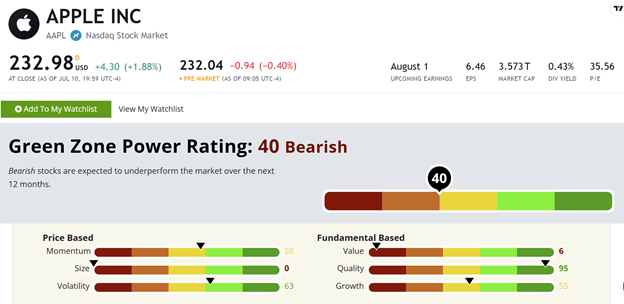It’s easy to get overwhelmed and plunge down the “rabbit hole” when you start researching a new stock…
What starts with some innocent googling can rapidly evolve into long hours of skimming financial reports, fiddling with charts and gleaning tidbits of wisdom from an endless army of Wall Street pundits.
There are endless mountains of data coming out of these companies too. Hence why some analysts spend their entire careers focusing on just a single stock.
Unfortunately, we don’t have that luxury.
To maximize our returns and make the most out of our investments, we need to keep up with an entire portfolio of stocks.
That requires us to prioritize the research that really matters — and focus on the key factors that will actually impact our bottom line.
You might already know that my Green Zone Power Ratings system focuses on just 6 key factors for each stock.
Because through decades of historical analysis, these are the factors that make the difference.
If a stock ranks high enough across these six categories, then it’s likely to beat the S&P 500 by at least 3-to-1.
Here’s a quick look at each key “Green Zone Power Factor,” along with an explanation of why it’s so important…
Green Zone Power Factor #1: Momentum
Momentum is arguably the most important factor for determining whether it’s the right time to invest in a stock.
You might find a stock that’s a great value, with impressive metrics and good fundamentals. But if the momentum isn’t there, it’s simply dead in the water.
And a stock like that can stay dead in the water for years, as we’ve observed on numerous occasions.
In the simplest terms, momentum boils down to buying “buying high and selling higher,” according to the earliest momentum traders.
To go a little deeper, momentum works because it targets the “behavioral” nature of stock investing.
The behavioral side of investing creates certain biases that I’ve talked about with my Green Zone Fortunes subscribers. These biases, or “mental glitches,” as I like to call them, are baked into the human psyche.
They systematically create the mispricing of stocks, whereby they are either underpriced or overpriced for some period of time.
And it’s the mispricing of stocks that momentum investors take advantage of to earn market-beating returns.
Green Zone Power Factor #2: Size
The academic research is clear: small companies outperform large companies, in aggregate, over the long run.
I understand that smaller companies can carry more risk. But if you hold a diversified portfolio of small companies, you can make more money buying these somewhat riskier small-cap stocks than you can piling into the big names.
That doesn’t mean that microcaps and penny stocks automatically get a high Green Zone Power Rating. But it also doesn’t help those dominant mega-cap stocks with sky-high valuations.
Green Zone Power Factor #3: Volatility
As you probably already know, volatility measures how “steady” a stock is performing.
Higher volatility typically means share prices are all over the place. Up 30% one day, down 30% the next. That might be appealing to some options traders out there, but it’s a nightmare for Main Street investors.
So it’s something my system accounts for.
Just remember that we reverse the typical association with volatility. So if a stock has a higher volatility score, that actually means it’s less volatile.
Counter-intuitive at first, but once you start using the system, you’ll see why I set it up that way.
Green Zone Power Factor #4: Value
When you hear the word “value” in relation to investing, you probably think of the famed investor Warren Buffett.
The value factor in Green Zone Power Ratings represents the same kind of strict assessment of a stock’s financial statements. It uses popular metrics such as price-to-earnings and price-to-book to determine if a stock is “cheap” or not.
Value is still a critical factor when it comes to finding the right investments, as long as it’s weighted against other critical factors including…
Green Zone Power Factor #5: Quality
As you might imagine, the concept of “Quality” is difficult to express on a numerical scale from 0 to 100.
Ultimately, I built this category as a composite of 27 different individual metrics. It’s perhaps the most classically “fundamental” factor of them all.
Without getting into the weeds too much, my system determines quality by looking at a company’s profitability. It uses metrics including return on assets, equity and invested capital. It also considers a company’s debt load and operational efficiency.
The quality factor does a great job distinguishing high-quality companies worth considering and the “junk” that, at any price, we should leave alone.
Green Zone Power Factor #6: Growth
Growth is another critical factor that might seem to speak for itself.
But I should point out that Green Zone Power Ratings is more focused on identifying high-growth industries rather than just focusing on rapidly growing stocks.
In other words, this category is meant to quantify the tailwinds that are steadily driving a stock (or even an entire sector) higher.
For example, look no further than meme stock darling Gamestop (NYSE: GME).
GME’s share prices soared nearly 60% over the last six months. But since it’s selling physical games at brick-and-mortar retail locations, GME is essentially at the intersection of two dying industries. So its Growth score has topped out at a meager 36/100.
Meanwhile, Nvidia (Nasdaq: NVDA) has reached stratospheric valuations. But since it’s in the AI business, its Growth score remains pegged at 100/100.
A Practical Recipe for Beating the Market 3-to-1
Once we have a score for each of these six categories, we simply add those scores together and average them out to get a stock’s Green Zone Power Rating, like the one below for Apple (Nasdaq: AAPL):

(Click here to view larger image.)
You might be surprised to see AAPL rating so low. But the numbers really speak for themselves here…
AAPL shares have already soared more than 345% over the last five years, but that momentum has decidedly slowed in the last year. Volatility is likewise unfavorable, with multiple extended declines over the last year.
AAPL still scores off the charts on Quality, and rightly so. Apple’s return on equity (ROE) — the measure of the financial performance of a company by dividing its net income by shareholder equity — is particularly strong.
AAPL’s current ROE is 147%, compared to the communication equipment industry average of negative -1.5%.
But like the other mega-cap tech stocks, AAPL struggles with extreme low scores on Value (due to its premium valuation) and Size (due to its $3.4 trillion market cap). There’s very little room for AAPL to grow in either regard.
We learn all that from a quick glance at the stock’s rating.
Instead of spending hours researching “in circles” … instead of following a hunch or a hot tip from your broker, just use my free Green Zone Power Ratings tool HERE to shortcut hours of research.
If you stick to your discipline and invest only in “Strong Bearish” stocks, then you’ll be on track to beat the market 3-to-1.
To good profits,

Chief Investment Strategist, Money & Markets









